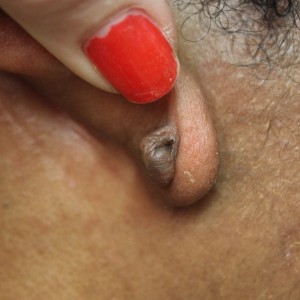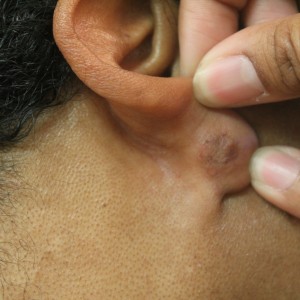Fine Touch Dermatology offers effective Keloid Treatment for those who have scars made of keloid tissue.
What Is A Keloid?
A keloid is a raised scar which grows over normal skin. It is made of specific types of collagen. This tissue appears very different across different patients. Here are a few descriptions:
1) Rubbery firm texture
2) Shiny and fibrous
They also range in colors:
1) Pink
2) Skin colored
3) Red
4) Dark brown
Keloid Symptoms
In addition to their physical appearance, keloids are also accompanied by physical sensations such as:
1) Sharp pains
2) itching
How Does A Keloid Develop?
Keloids develop within the scar tissue after an abrasion or wound occurs on the skin. They are made of two types of collagen which include:
1) Type 1 collagen (late)
2) Type 3 collagen (early), also known as granulation tissue
After the skin is injured and starts to heal, the type 3 collagen will overgrow. It will then be replaced by the type 1 collagen. Keloid scars will grow past the boundaries of the original wound.
Keloids are not always the result of a wound. They can develop from a simple scratch, pimple, insect bites or body piercings.
Some people are predisposed to developing keloids. Knowing this is helpful for preventing their occurrences. These individuals are advised to avoid piercings, unnecessary trauma and certain types of surgery.
Keloid Treatment
Treatment for keloids will differ on a case by case basis. Here is a list of common interventions used for keloid patients
- Surgical excision
- Pulsed dye laser treatment
- Corticosteroids
- Cryotherapy
- Grenz Zone Radiation therapy
Keloid Treatment By Keloid-flap Surgical Excision
Keloid-flap surgery involves the closing of the keloid scar using the keloid itself to form a flap. Using a flap to close the wound primarily inhibits the scar forming signal the wound requires to form a scar. Dr. U performs this method to reduce the need to sustained and indefinite steroid injections or maintenance treatment. This innovative method inhibits further scar and keloid formation in the long term. The effectiveness of this approach is highlighted in the results shown in this patient at 1 year after surgery. She only received 2 steroid injections in the immediate aftermath of the Keloid-flap surgery by Dr U:
Keloid Consultations For Redondo Beach Patients
Fine Touch Dermatology offers free consultations for patients with keloid scars. This is an excellent opportunity for individuals to learn more about their condition and what sort of treatment would be best for their individual case.
If you are interested in signing up for a consultation, fill out our online form at the top of the page. You may also call our office at 877-337-6424.
Read more about keloid scars here: http://www.webmd.com/skin-problems-and-treatments/tc/keloid-scars-topic-overview


